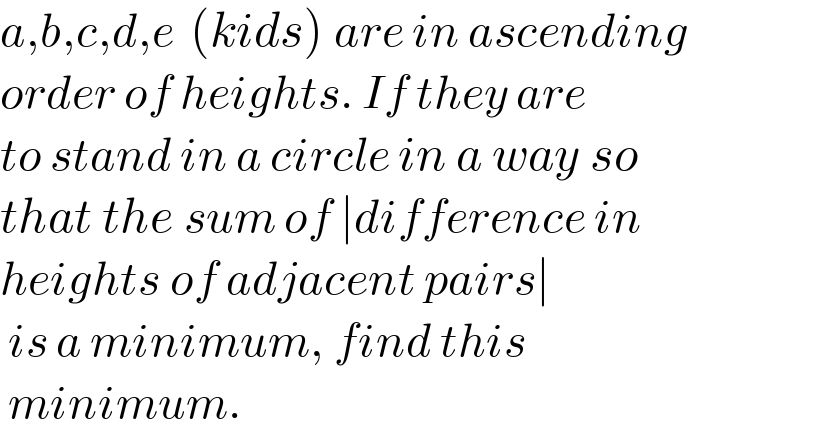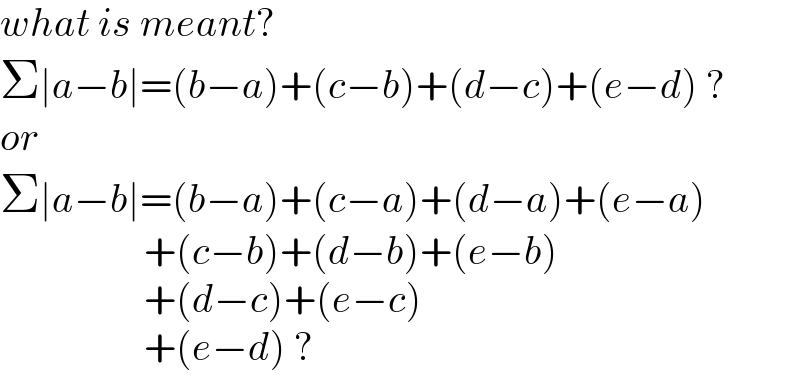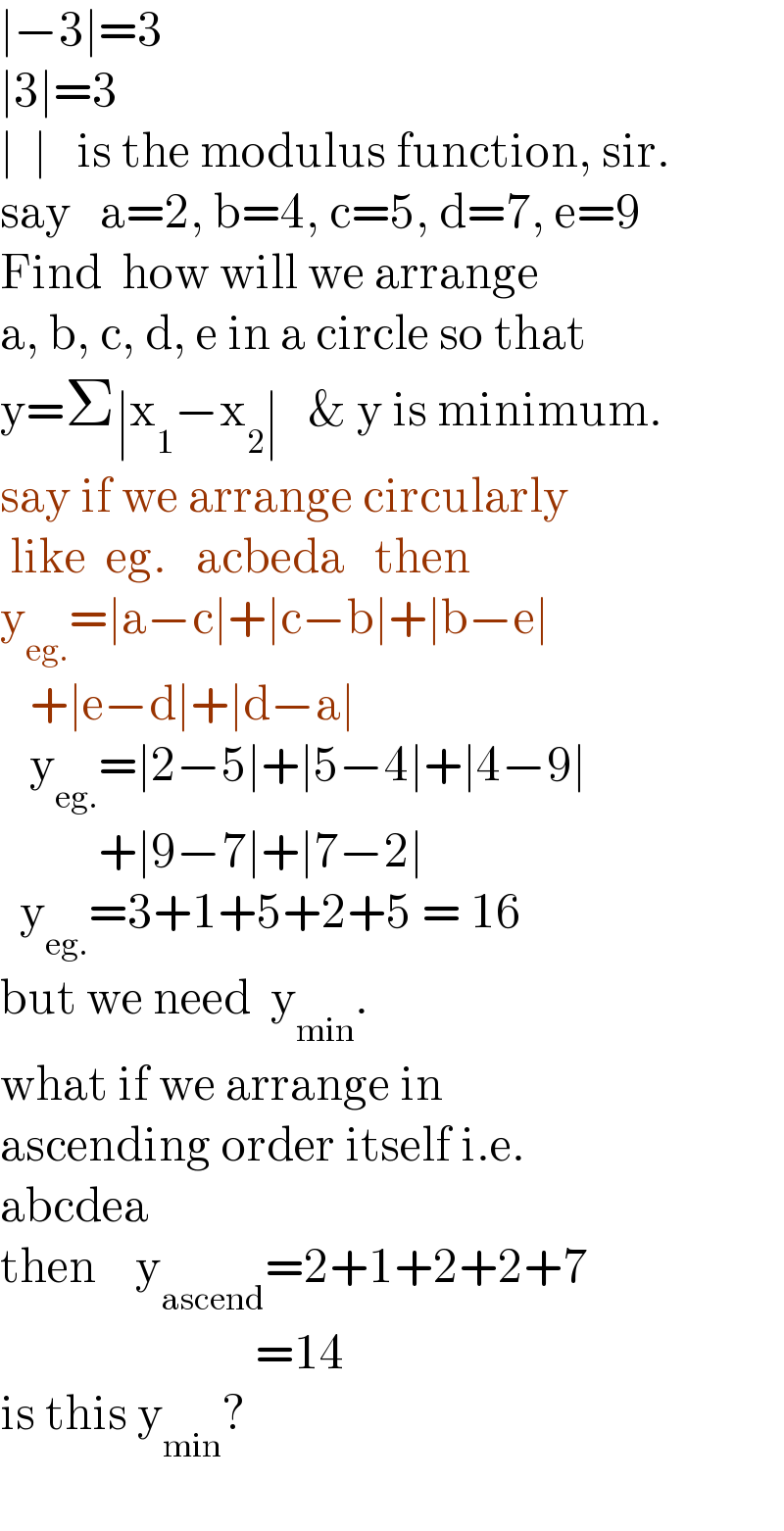Question Number 155797 by ajfour last updated on 09/Oct/21

$${a},{b},{c},{d},{e}\:\:\left({kids}\right)\:{are}\:{in}\:{ascending} \\ $$$${order}\:{of}\:{heights}.\:{If}\:{they}\:{are} \\ $$$${to}\:{stand}\:{in}\:{a}\:{circle}\:{in}\:{a}\:{way}\:{so} \\ $$$${that}\:{the}\:{sum}\:{of}\:\mid{difference}\:{in} \\ $$$${heights}\:{of}\:{adjacent}\:{pairs}\mid \\ $$$$\:{is}\:{a}\:{minimum},\:{find}\:{this} \\ $$$$\:{minimum}. \\ $$
Commented by ajfour last updated on 09/Oct/21

$$\left(\Sigma\mid\mathrm{a}−\mathrm{b}\mid\right)_{\mathrm{min}} =? \\ $$$$\mathrm{sir}? \\ $$
Commented by mr W last updated on 05/Oct/21

$${a},{b},{c},{d},{e}\:{are}\:{given},\:{so}\:{the} \\ $$$${sum}\:{is}\:{always}\: \\ $$$$\left({e}−{d}\right)+\left({d}−{c}\right)+\left({c}−{b}\right)+\left({b}−{a}\right)={e}−{a} \\ $$
Commented by mr W last updated on 05/Oct/21

$${any}\:{circle}\:{with}\:{diameter}\:\geqslant{e}\:{is}\:{ok}. \\ $$
Commented by mr W last updated on 09/Oct/21

$${what}\:{is}\:{meant}? \\ $$$$\Sigma\mid{a}−{b}\mid=\left({b}−{a}\right)+\left({c}−{b}\right)+\left({d}−{c}\right)+\left({e}−{d}\right)\:? \\ $$$${or} \\ $$$$\Sigma\mid{a}−{b}\mid=\left({b}−{a}\right)+\left({c}−{a}\right)+\left({d}−{a}\right)+\left({e}−{a}\right)\: \\ $$$$\:\:\:\:\:\:\:\:\:\:\:\:\:\:\:\:\:\:+\left({c}−{b}\right)+\left({d}−{b}\right)+\left({e}−{b}\right) \\ $$$$\:\:\:\:\:\:\:\:\:\:\:\:\:\:\:\:\:\:+\left({d}−{c}\right)+\left({e}−{c}\right) \\ $$$$\:\:\:\:\:\:\:\:\:\:\:\:\:\:\:\:\:\:+\left({e}−{d}\right)\:? \\ $$
Commented by ajfour last updated on 09/Oct/21

$$\mid−\mathrm{3}\mid=\mathrm{3}\:\: \\ $$$$\mid\mathrm{3}\mid=\mathrm{3} \\ $$$$\mid\:\:\mid\:\:\:\mathrm{is}\:\mathrm{the}\:\mathrm{modulus}\:\mathrm{function},\:\mathrm{sir}. \\ $$$$\mathrm{say}\:\:\:\mathrm{a}=\mathrm{2},\:\mathrm{b}=\mathrm{4},\:\mathrm{c}=\mathrm{5},\:\mathrm{d}=\mathrm{7},\:\mathrm{e}=\mathrm{9} \\ $$$$\mathrm{Find}\:\:\mathrm{how}\:\mathrm{will}\:\mathrm{we}\:\mathrm{arrange} \\ $$$$\mathrm{a},\:\mathrm{b},\:\mathrm{c},\:\mathrm{d},\:\mathrm{e}\:\mathrm{in}\:\mathrm{a}\:\mathrm{circle}\:\mathrm{so}\:\mathrm{that} \\ $$$$\mathrm{y}=\Sigma\mid\mathrm{x}_{\mathrm{1}} −\mathrm{x}_{\mathrm{2}} \mid\:\:\:\&\:\mathrm{y}\:\mathrm{is}\:\mathrm{minimum}. \\ $$$$\mathrm{say}\:\mathrm{if}\:\mathrm{we}\:\mathrm{arrange}\:\mathrm{circularly} \\ $$$$\:\mathrm{like}\:\:\mathrm{eg}.\:\:\:\mathrm{acbeda}\:\:\:\mathrm{then} \\ $$$$\mathrm{y}_{\mathrm{eg}.} =\mid\mathrm{a}−\mathrm{c}\mid+\mid\mathrm{c}−\mathrm{b}\mid+\mid\mathrm{b}−\mathrm{e}\mid \\ $$$$\:\:\:+\mid\mathrm{e}−\mathrm{d}\mid+\mid\mathrm{d}−\mathrm{a}\mid \\ $$$$\:\:\:\mathrm{y}_{\mathrm{eg}.} =\mid\mathrm{2}−\mathrm{5}\mid+\mid\mathrm{5}−\mathrm{4}\mid+\mid\mathrm{4}−\mathrm{9}\mid \\ $$$$\:\:\:\:\:\:\:\:\:\:+\mid\mathrm{9}−\mathrm{7}\mid+\mid\mathrm{7}−\mathrm{2}\mid \\ $$$$\:\:\mathrm{y}_{\mathrm{eg}.} =\mathrm{3}+\mathrm{1}+\mathrm{5}+\mathrm{2}+\mathrm{5}\:=\:\mathrm{16} \\ $$$$\mathrm{but}\:\mathrm{we}\:\mathrm{need}\:\:\mathrm{y}_{\mathrm{min}} . \\ $$$$\mathrm{what}\:\mathrm{if}\:\mathrm{we}\:\mathrm{arrange}\:\mathrm{in} \\ $$$$\mathrm{ascending}\:\mathrm{order}\:\mathrm{itself}\:\mathrm{i}.\mathrm{e}. \\ $$$$\mathrm{abcdea} \\ $$$$\mathrm{then}\:\:\:\:\mathrm{y}_{\mathrm{ascend}} =\mathrm{2}+\mathrm{1}+\mathrm{2}+\mathrm{2}+\mathrm{7} \\ $$$$\:\:\:\:\:\:\:\:\:\:\:\:\:\:\:\:\:\:\:\:\:\:\:\:\:\:=\mathrm{14} \\ $$$$\mathrm{is}\:\mathrm{this}\:\mathrm{y}_{\mathrm{min}} ? \\ $$$$ \\ $$
Commented by mr W last updated on 09/Oct/21

$${now}\:{i}\:{understand}\:{the}\:{question}.\:{i}'{ll} \\ $$$${think}\:{about}\:{it}\:{again}. \\ $$
